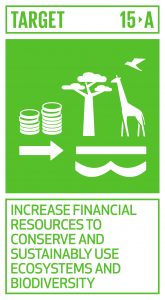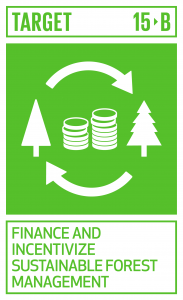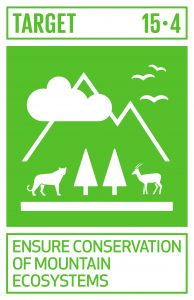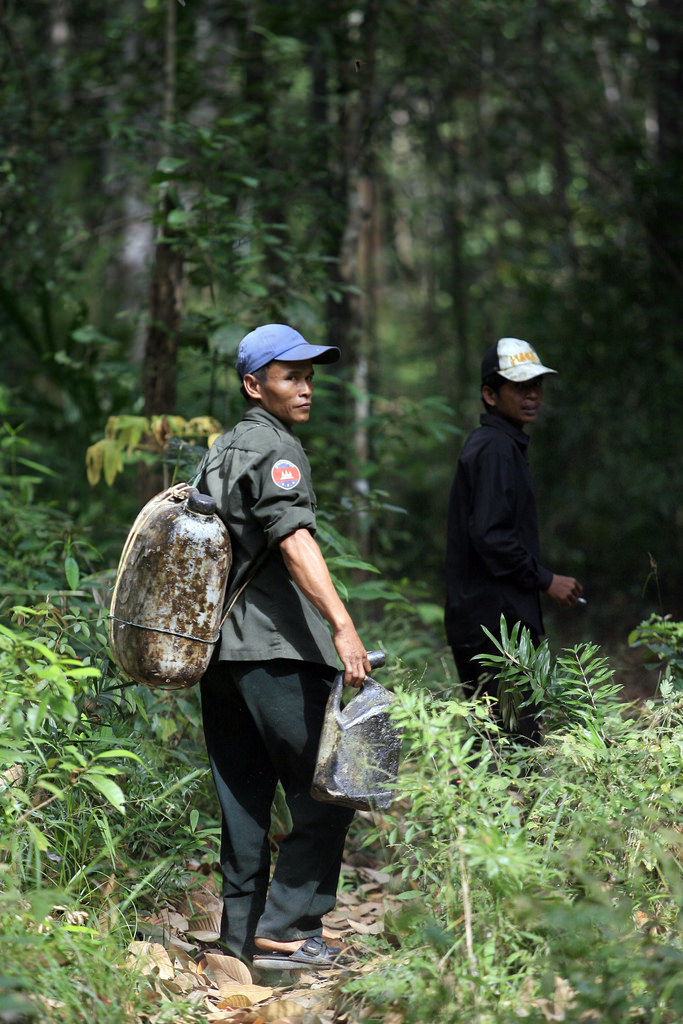SDG 15 focuses on the sustainable use of terrestrial (land-based) biodiversity and ecosystems such as forests, grasslands, deserts and mountains and their interaction with freshwater systems. It aims to protect and restore their ecological function. The work includes applying sustainable land and forest management practices and reducing ecosystem damage to prevent further losses to biodiversity.1
   |    |    |    |
The 12 targets for SDG 15 are outlined in the icons above. They have been designed to reduce the pressures placed on land-based ecosystems by shifting to more sustainable forms of agricultural and industrial management.
Progress towards these targets will be measured by 14 different indicators. Three of the indicators are related to the ‘means of implementation’ targets for SDG 15, which are intended to ensure there are enough finances (target 15.A) available to meet these goals, especially in developing countries (target 15.B). There is also an aim to cooperate globally to provide sustainable livelihood opportunities and protect flora and fauna from the illegal wildlife trade (target 15.C).2
Transition from the MDG targets to SDG 15 in Cambodia
The Millennium Development Goals (MDGs) that preceded the SDGs had a focus on social development. There was only one goal (MDG 7) focused on ensuring environmental sustainability3 and only ten environmentally focussed indicators limited to one goal. For the SDGs there are 86 indicators, integrated across all 17 SDG targets. Three of the MDG indicators are repeated for SDG 15. These are the proportion of forested land, the proportion of terrestrial protected areas and the proportion of species threatened with extinction.4
The SDG targets related to land-based ecosystems are both greater in number and more specific about what is required to achieve sustainable development outcomes (MDG target 7.A) and significantly reduce biodiversity losses (MDG target 7.B).5 The SDGs also recognise that land-based ecosystems must be protected by the global community, directly involving marginalised people in their management to share the benefits of sustainable use in a fair and equitable way.6
For example, to achieve a reversal of environmental losses, the Cambodian Millennium Development Goals (CMDGs) set a forest cover target of 60% by 2015. Several indicators referred to the use of protected areas to prevent biodiversity losses, including a total area of protected ecosystems of 3.3 million hectares and six new protected forests of 1.35 million ha.7
However, despite these targets, Cambodia experienced the ‘highest degree of tree-cover loss in the world over the past 14 years’.8 Forest cover was reported to be as low as 48% by 2014, 9 significantly lower than the MDG target. The localised CSDGs have not been released yet, but forest cover loss represents a significant challenge for their implementation.
Localization of SDG 15 in Cambodia
In 2016, a rapid integrated assessment of Cambodia’s national development plans and policies was conducted to assess how well the country was prepared to implement SDG 15 and other goals. It found that in Cambodia most targets were covered but the country would need to develop further strategies to meet SDG target 15.4 (ensure the conservation of mountain ecosystems). For example, the National Strategic Development Plan (NSDP) (2014–2018) refers to an elephant conservation project in the Cardamom Mountains, but specific plans capable of meeting SDG Target 15.4 were not included in either the NSDP or the National Biodiversity Strategy and Action Plan (NBSAP) (2016).10 The NBSAP suggests that there are knowledge gaps regarding ecosystem services provided by mountains in Cambodia.11
Beyond SDG 15.4, the Royal Government of Cambodia (RGC) has plans that should help achieve SDG 15’s targets and indicators:
- The National Forest Program 2010–2029 12 is consistent with the long-term targets of other plans aiming for 60% or 10.9 million hectares of forest cover by 2029. Under this plan, significant amounts of forestland under private concession are expected to be converted into state-owned production forests or Forestry Administration-managed protected forests. A Production Forest Strategic Plan (2018–2032) is also expected to be released in 2018.13
- The draft US$43 million Cambodian National Action Plan to Combat Land Degradation (2017–2026) has been launched to improve the enabling environment for addressing land management issues and several programs have been proposed.14 For example, the FAO’s forest and landscape restoration mechanism (FLRM) work plan for Cambodia 2016–2018 was endorsed by the RGC in 2016 15 with the aim of assessing the nature of land issues in Cambodia and their links with governance issues. It is also intended to identify appropriate ways of accessing resources to resolve these issues in line with Aichi Biodiversity Target 15, including through the private sector.16 Another approach is the Collaborative Management for Watershed and Ecosystem Service Protection and Rehabilitation (CoWES) project aimed at demonstrating how land degradation can be reversed in Prek Tnout, Kampong Speu, using collaborative watershed management.17
- In 2016, the second version of Cambodia’s National Biodiversity Strategy and Action Plan was released.18 To facilitate meeting SDG target 15.5, it shows how Cambodia will develop small to medium enterprises (SMEs) in production forest cantonments to add greater value to existing wood and non-timber forest products and discourage habitat degradation in protected areas.19 This plan also contains strategies for addressing the illegal poaching of flora and fauna and the illegal wildlife trade, through setting up informant networks around critical protected areas (SDG target 15.7).

A resin production community member on the way to collect resin from a community forest in Sam Bo District, Kratie province. Photo by Oxfam GB. Licensed under CC BY NC-ND 2.0.
- In 2015, Cambodia become a party to the Nagoya Protocol on access to genetic resources and the fair and equitable sharing of benefits arising from their utilization.20 The country can contribute to the sustainable use of global biodiversity resources and meet SDG target 15.6 by following the requirements of this legal framework.21
- In May 2016, the Ministry of Environment developed the National Invasive Species Strategy and Action Plan (NISSAP) in line with the NBSAP.22 To meet SDG target 15.8, this plan must be adequately resourced.
- In 2015, Cambodia released new National Biodiversity Targets and Indicators, linked to Aichi Biodiversity Target (2) to integrate biodiversity values into national and sub-national development plans with increased budgets for managing biodiversity. These localized plans are relevant for achieving SDG target 15.9.23
Means of implementation for SDG 15 in Cambodia
The first two means implementation targets (15.A and 15.B) both refer to increasing the amount of financial resources mobilised for the conservation and sustainable use of biodiversity and ecosystems. Target 15.B is more specific and refers to ensuring that these financing mechanisms provide incentives for developing countries, such as Cambodia, to implement sustainable forest management.
Cambodia’s National Forest Program (NFP) 2010–2029 identifies six program areas to be resources through a Sustainable Forest Financing program. It identifies five major financing sources:
- Government funding
- National forestry income, such as through state-owned enterprises
- Private sector income, including through community forestry
- Donor funding
- Innovative sources such as eco-tourism and carbons credits.24
Cambodia relies heavily on funding from donors to support this program and this will not be sufficient to implement it through to 2029 and meet SDG 15. There are currently few mechanisms to collect revenue from the forestry sector and this means that private sector involvement in sustainable forestry is low.25
The NFP outlines a plan for self-financing of sustainable forestry, initially based on donor and government funding, before transitioning to more income from carbon markets and potentially low-impact logging, certification and exports.
In the long term, Cambodia can best manage and protect its forest areas by accessing diverse funding sources, becoming less reliant on donor and government funding. This will mean that forests can be protected even in economic downturns.
The Forest Administration is considering many options for this including:
- Taxes on legal trade in forest products
- Public-private partnerships related to income-generating conservation activities on economic land concessions
- Impact investment from donors
- Payment for environmental services (PES) schemes linked to tourism, watershed management and carbon sequestration
- ‘Debt-for-nature swaps’
- Sustainable and forest conservation investment funds
- Industrial biodiversity and forestry offsets.26
SDG target 15.C has two components – better global support for preventing poaching and trafficking of protected species and enabling local communities to pursue sustainable livelihood opportunities.27 This is important as in some circumstances, the legal mechanisms intended to stop poaching and trafficking have been observed to affect indigenous best management practices and trading patterns that have been successfully used historically to conserve biodiversity. 28
The illegal wildlife trade issue is difficult to resolve. It often requires the cooperation of multiple government ministries across international borders to address, is highly profitable and is often a low priority for governments with limited resources. Co-operation on this issue to date has seen recommendations made regarding clearer legal frameworks and specialised enforcement agencies for wildlife crimes. Mutual assistance treaties with neighbouring countries have also been considered.29 `
Monitoring SDG 15 in Cambodia
Many of the indicators for SDG 15 in Cambodia are already available. The current progress regarding the development and measurement of these indicators is presented in the following table.
Indicator | Availability | Comments |
15.1.1 | Percentage forest cover has steadily declined from 73.3% in 1990 to 53.6% in 2015 (FAO) 30 | Independent monitoring using satellite data suggests that this figure may be even lower than this (48% in 2014).31 |
15.1.2 | 26.03% of Cambodia’s terrestrial areas is covered by protected areas (UNEP).32 | The data for Cambodia has not yet been disaggregated for specific terrestrial ecosystems. |
15.2.1 | Cambodia will report on this indicator in detail through the next Global Forest Resource Assessment in 2020.33 | This is assessed based on 5 sub-indicators: (i) net change in forested areas; (ii) above ground biomass in forests; as well as the proportion of forests: (iii) within legally protected areas; (iv) under a long term management plan; and (v) under certification.34 |
15.4.1 | No specific data disaggregated yet for Cambodia (UNEP). 35 | The data for Cambodia has not yet been disaggregated for specific terrestrial ecosystems. |
15.4.2 | The baseline for the region was determined by the FAO’s 2015 Global Mountain Map.36. However, more intensive analysis will be required to produce results specific to Cambodia. | The Mountain Green Cover Index measures changes in the area covered by forests, grasslands and crops compared to the total area of mountains.37. |
15.5.1 | The Red List Index is a global or regional indicator used to indicate changes in biodiversity levels and is measured by major species groups. not confined to national borders. | Only the number of threatened species for each taxonomic group, as well as the total number of plant and animal species for each Red List category are available at the country level.38 |
15.6.1 | Cambodia has signalled its intent share benefits related to genetic resources (Indicator 15.6.1) and has signed the Nagoya Protocol. Global data is available from the CBD’s Access and Benefit Sharing Clearing House39 | Other sub indicators include reporting the countries legal and policy frameworks to the Convention of Biological Diversity and documenting the sharing of genetic material with other countries40 |
The remaining seven indicators are currently classified as either Tier II or Tier III by the United Nations Statistics Division (UNSD), which means that data is not available either because it is not regularly produced by all countries (Indicators 15.3.1, 15.7.1, 15.8.1, and 15.C.1) or the method for generating the data has not yet been finalised (Indicators 15.A.1, 15.B.1, and 15.9.1).41 More information about these indicators is likely to be released after the High Level Political Forum meeting in July 2018, where SDG 15 will be reviewed.42
Related Topics
References
- 1. “Sustainable Development Goal 15,” Sustainable Development Knowledge Platform, accessed June 29, 2018.
- 2. Ibid.
- 3. “MDG Targets and Indicators,” UN NGLS, accessed June 29, 2018.
- 4. “Submission to the Higher Level Political Forum,” Sustainable Development Knowledge Platform, accessed May 29, 2018.
- 5. “MDG Targets and Indicators,” UN NGLS, accessed July 4, 2018.
- 6. “Sustainable Development Goal 15,” Sustainable Development Knowledge Platform, accessed June 29, 2018.
- 7. Royal Government of Cambodia,,“Cambodian Millennium Development Goals Report 2003” (Phnom Penh, 2003), 112.
- 8. Sivhouch, Ou and Sreang, Chheat 2015. Analysis of Cambodia’s Preparedness for the Implementation of Sustainable Development Goals: Challenges, Opportunities and Financing. Phnom Penh: Cooperation Committee for Cambodia, 2015.
- 9. “Forest Cover,” Open Development Cambodia, accessed May 29, 2018.
- 10. “Rapid Integrated Assessment – Cambodia SDG scorecard profile,” United Nations in Cambodia, accessed May 29, 2018.
- 11. Royal Government of Cambodia, National Biodiversity Strategy and Action Plan (Phnom Penh, 2016), 227.
- 12. Royal Government of Cambodia, National Biodiversity Strategy and Action Plan (Phnom Penh, 2016), 227.
- 13. Nick Beresford and Moeko Saito-Jensen, «Why care about Cambodia’s forests?,» The Phnom Penh Post, March 22, 2018.
- 14. United Nation Development Programme 2017. “Collaborative management for watershed and ecosystem service protection and rehabilitation in the Cardamom mountains, upper Prek Thnot river basin (CoWES)”. Accessed June 01, 2018.
- 15. “The forest and landscape restoration mechanism in Cambodia,” Food and Agriculture Organization of the United Nations, accessed May 29, 2018.
- 16. Beacier, Christophe and McGuire, Douglas.“The forest landscape restoration mechanism: FAO effort to contribute to the Bonn challenge in the context of the The Global Partnership on Forest and Landscape Restoration (GPFLR)”. Presentation, Ankara, 2015. Accessed on 01 June 2018.
- 17. United Nation Development Programme 2017. “Collaborative management for watershed and ecosystem service protection and rehabilitation in the Cardamom mountains, upper Prek Thnot river basin (CoWES)”. Accessed June 29, 2018.
- 18. Royal Government of Cambodia, National Biodiversity Strategy and Action Plan (Phnom Penh, 2016), 227.
- 19. United Nation Development Programme (UNDP). National Biodiversity Strategies and Action Plans: natural catalysts for accelerating action on Sustainable Development Goals. New York: UNDP, 2016.
- 20. “Parties to the Nagoya Protocol”,” Convention on Biological Diversity, accessed June 1, 2018.
- 21. “About the Nagoya Protocol,” Convention on Biological Diversity, accessed June 1, 2018.
- 22. National Council for Sustainable Development (NCSD) and Ministry of Environment, National Invasive Species Strategy and Action Plan (NISSAP) 2016 (Phnom Penh, 2016), 227. Accessed June 12, 208.
- 23. Department of International Conventions and Biodiversity/GDANCP 2015. “Cambodian Biodiversity Targets and Indicators”. Accessed June 2018.
- 24. Royal Government of Cambodia, National Forest Program 2010-2029 (Phnom Penh, 2010), 146..
- 25. Ministry of Agriculture Forestry and Fisheries, Sustainable finance mechanisms for conservation of forests and protected areas in Cambodia: Finance options assessment report (Phnom Penh, 2016), 90.
- 26. Ibid
- 27. “The EU and WWF sign a 2.8 million EUR agreement to conserve natural resources in Cambodia,” WWF Cambodia, accessed May 30, 2018.
- 28. Andrew, Dale. Trade and SDG 15: Promoting “Life on Land” through mandatory and voluntary approaches. Tokyo: Asian Development Bank Institute, 2017. Accessed June 12, 2018.
- 29. “Cambodia’s ministries come together to address wildlife trafficking,” WCS Newsroom, accessed May 30, 2018.
- 30. “Forest area (% of land area)”, The World Bank 2015, accessed June 1, 2018.
- 31. “Forest cover reporting”, Open Development Cambodia, accessed May 30, 2018.
- 32. “Protected area profile for Cambodia from the World Database of Protected Areas,” Protected planet, accessed July 3, 2018.
- 33. Food and Agriculture Organization of the United Nations (FAO). Global Forest and Resources Assessment:Guidelines and specifications. FRA 2020. Version 1.0. Rome: FAO, 2018.
- 34. F“SDG Indicator 15.2.1 – Progress towards sustainable forest management,” Food and Agriculture Organization of the United Nations, accessed June 1, 2018.
- 35. “Protected area profile for Cambodia from the World Database of Protected Areas,” Protected planet, accessed July 3, 2018.
- 36. Vita, Alessia. “Mapping and understanding mountains to achieve the 2030 Agenda.” Presentation, FAO Headquarters Rome, 2016.
- 37. “Keeping an eye on SDG 15: Working with countries to measure indicators for forests and mountains”, Food and Agriculture Organization of the United Nations, accessed June 2, 2018.
- 38. “Summary statistics,” The IUCN Red List of Threatened Species, accessed June 2, 2018.
- 39. “The Access and Benefit Sharing Clearing House,” ABSCH, accessed June 2, 2018.
- 40. “SDG Indicator 15.2.1 – Progress towards sustainable forest management,” Food and Agriculture Organization of the United Nations, accessed June 2, 2018.
- 41. United Nations Statistics Division (UNSD). 2018. Tier classification for Global SDG Indicators.
- 42. “High Level Political Forum on Sustainable Development,” Sustainable Development Knowledge Platform, accessed June 2, 2018.

